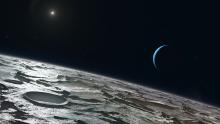Listen to today's episode of StarDate on the web the same day it airs in high-quality streaming audio without any extra ads or announcements. Choose a $8 one-month pass, or listen every day for a year for just $30.
You are here
Neptune Opposition III
The planet Neptune was discovered 175 years ago this month. Its biggest moon, Triton, was found just 17 days later. But Neptune’s second-biggest moon wasn’t discovered until more than 140 years after that. It’s so small, dark, and close to Neptune that it remained hidden in the planet’s glare.
Proteus is about 250 miles in diameter, and its surface is as dark as charcoal. It has a boxy shape, and it’s been battered by countless space rocks.
Proteus and many of Neptune’s other known moons — there are 14 in all — may have been influenced by Triton. Triton follows a “backward” orbit around Neptune — it orbits in the opposite direction from the planet’s rotation. That suggests it started life elsewhere in the solar system and was captured by Neptune’s gravity.
Triton’s gravity could have caused some of Neptune’s existing moons to ram together and shatter, forming a disk of debris. Other moons may have coalesced from that debris — including Proteus.
Later, another big space rock may have hit Proteus, chipping off a big chunk of the moon. That chunk entered orbit on its own, forming another small moon — a chip off the shoulder of Neptune’s second-largest moon.
Neptune is in the sky all night right now. It’s near the intersection between Pisces and Aquarius. It shines brightest for the year as well. Even so, it’s so far and faint that you need help to find the giant planet with the unruly moons.
Script by Damond Benningfield




